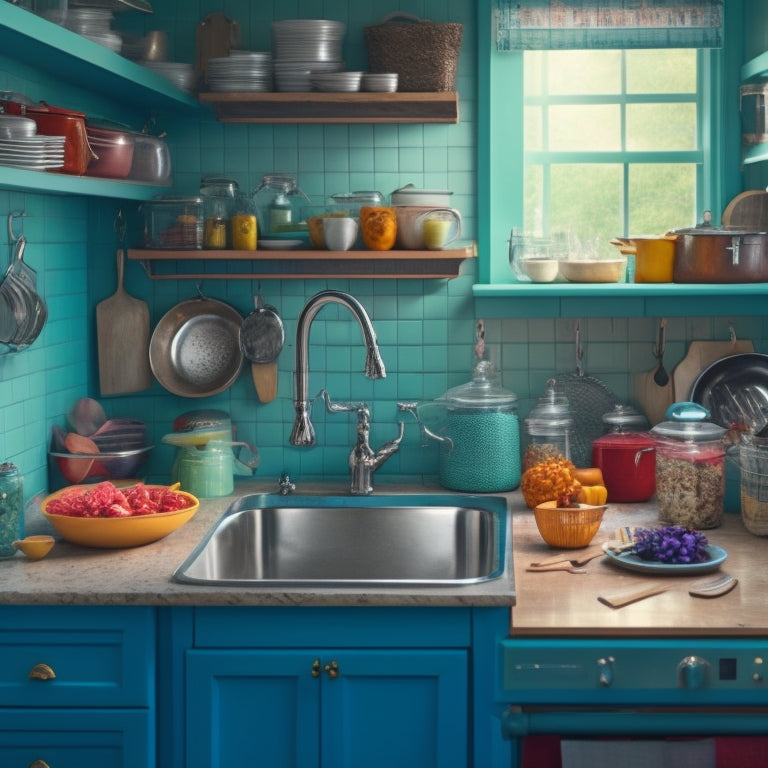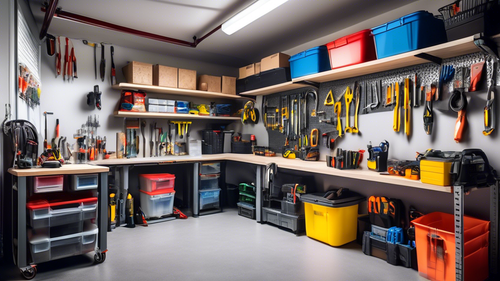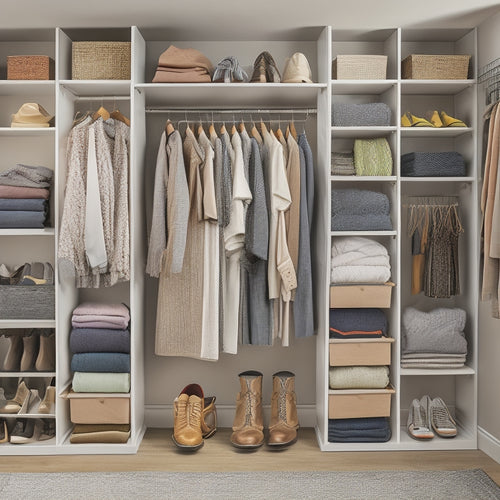
Tame Kitchen Chaos: 10 Essential Decluttering Tips
Share
To tame kitchen chaos, start by clearing everything off your countertops and categorizing items into groups. Then, purge expired goods, broken items, and anything you haven't used in a while. Assign a home for each item, utilizing strategies like color-coding and vertical storage. Optimize your cabinet space by maximizing vertical storage and using hanging pots and baskets. Implement the "one in, one out" rule to maintain your newly organized space. Designate a "landing strip" for incoming items and schedule regular maintenance to keep your kitchen running smoothly. Now that you've got a solid foundation, take the next step to transform your kitchen into a clutter-free haven.
Key Takeaways
• Clear countertops by removing items, categorizing them, and assigning specific spots to create a sense of organization and flow.
• Purge expired goods, broken items, and unused kitchen tools to free up space and reduce clutter.
• Optimize cabinet storage by maximizing vertical space, using hanging pots and baskets, and installing wall hooks and shelves.
• Designate zones for meal prep, cooking, clean-up, and storage to create an efficient kitchen workflow and reduce chaos.
• Implement the 'one in, one out' rule to maintain a clutter-free kitchen and ensure that every item has a designated home.
Start With a Clean Slate
Clear everything off your kitchen counters and declutter your kitchen surfaces to create a blank canvas that's ready for organization. This is where you start fresh, wiping the slate clean to organize efficiently.
Remove everything from your countertops, including appliances, decorations, and clutter. Yes, it might feel overwhelming, but trust us, it's essential. Take this opportunity to dust and clean the surfaces, getting rid of any crumbs, spills, or stains.
Next, categorize items into groups, such as baking supplies, cooking utensils, and dinnerware. This will help you visualize what you have and where it should go. You might be surprised at how much more manageable your kitchen feels already.
Now, take a step back and assess your kitchen's layout. Identify zones, like a cooking station or a breakfast nook, to help you determine the most efficient use of space. With a clean slate, you're ready to start organizing your kitchen in a way that suits your lifestyle and cooking habits.
Purge Unwanted Kitchen Items
Now that your kitchen is sparkling clean, it's time to tackle the clutter. You'll need to get rid of items that are no longer serving a purpose, and that's where purging comes in.
Clear Out Expired Goods
Take a close look at the contents of your pantry, fridge, and kitchen cabinets, and you'll likely find at least a few items that are past their expiration dates or no longer serve a purpose. It's time to declutter efficiently and eliminate expired goods.
Check expiration dates on food items, spices, and condiments. Be ruthless – if it's past its prime, it's time to let it go.
Here are some common culprits to watch out for:
- Canned goods that are dented, rusted, or expired
- Spices that are stale or no longer fragrant
- Baking supplies that are past their expiration dates
- Opened jars or bottles that have been sitting on the shelf for months
- Medications or supplements that are no longer valid or safe to use
Donate Unused Gadgets
What gadgets are collecting dust on your kitchen countertops or hiding in your cabinets, serving no purpose but taking up valuable space? It's time to face the music and purge those unwanted kitchen items.
Start by gathering all your gadgets and appliances and categorize them into three piles: keep, donate, and discard. Be honest with yourself - when was the last time you used that spiralizer or egg slicer? If it's been over a year, it's probably safe to let it go.
Consider hosting a kitchen gadget swap with friends or family members to breathe new life into your unused items. You can also donate gently used gadgets to local charities or thrift stores.
Remember, decluttering challenges are all about making tough decisions, but the payoff is a more organized, streamlined kitchen that sparks joy. By letting go of the gadgets that no longer serve you, you'll create space for the ones that do.
Toss Broken Appliances
How many broken appliances are lingering in your kitchen, serving as a constant reminder of your procrastination? It's time to take action and declutter your kitchen by getting rid of those non-functional appliances. Don't let them occupy valuable space and collect dust. Instead, take a closer look at each appliance and decide its fate.
-
If it's beyond repair, consider recycling it to minimize electronic waste.
-
If it can be repaired, weigh the cost of repair against the cost of a new appliance.
-
If it's still in good condition but no longer serves a purpose, consider donating it to someone who might need it.
-
If it's an outdated model, think about upgrading to a newer, more energy-efficient version.
-
If it's a duplicate or no longer aligns with your kitchen needs, let it go and free up space for something more useful.
Assign a Home for Each Item
By designating a specific spot for every kitchen item, you'll guarantee that clutter doesn't accumulate in the first place. This organized approach will save you time and energy in the long run. Start by categorizing your kitchen items into groups, such as baking supplies, cooking utensils, and dinnerware. Then, assign a home for each group using an organizing strategy like color coding.
| Category | Assigned Home |
| Baking Supplies | Top shelf of pantry with color-coded labels |
| Cooking Utensils | Drawer with dividers near the stove |
| Dinnerware | Upper cabinet with easy access |
| Spices | Spice rack near the cooking station |
| Cleaning Supplies | Under-sink storage with labeled bins |
Optimize Cabinet Storage Space
Now that you've assigned a home for each item, it's time to optimize your cabinet storage space.
You'll want to make the most of this valuable real estate by maximizing vertical space, purging unwanted items, and utilizing those often-wasted hidden corners.
Maximize Vertical Space
You can instantaneously free up valuable floor space and countertops by installing shelf dividers, baskets, or turntables that capitalize on the often-wasted vertical real estate within your cabinets. This strategic move allows you to store more items in a smaller footprint, keeping your kitchen organized and clutter-free.
To maximize your cabinet's vertical space, consider the following:
-
Use hanging pots and baskets to store cookware, utensils, or spices, keeping them easily accessible while freeing up shelf space.
-
Install wall hooks to hang items like aprons, oven mitts, or even a kitchen utensil organizer.
-
Incorporate shelves to create additional storage for infrequently used items or special occasion dishes.
-
Utilize stackable containers to store dry goods like pasta, rice, or canned goods.
-
Implement adjustable shelving to accommodate items of varying sizes and shapes.
Purge Unwanted Items
With your cabinets' vertical space maximized, it's time to tackle the items you're storing, and get rid of anything that's no longer serving a purpose. This is where the real decluttering begins.
Take everything out of your cabinets and sort items into three piles: keep, donate/sell, and discard. Be ruthless – if you haven't used it in the past year, it's likely you won't miss it. Consider the 80/20 rule, where 80% of the time, you only use 20% of your belongings. This is especially true in the kitchen, where gadgets and gizmos can quickly accumulate.
As you're purging, keep your kitchen organization goals in mind. Envision a minimalist living space where every item has a designated home and serves a purpose. Ask yourself, 'Do I really need three different types of coffee makers?' or 'When was the last time I used this cake stand?'
Utilize Hidden Corners
Every cabinet has hidden corners and unused vertical space that can be optimized to store items like spices, oils, or cleaning supplies, freeing up valuable shelf space for more frequently used items. By utilizing these underutilized corners, you can create a more organized and efficient kitchen.
Here are some creative storage solutions to get you started:
-
Install corner shelves to store infrequently used items, such as special occasion dishes or cookbooks
-
Use hidden hooks to hang items like oven mitts, aprons, or utensils, keeping them out of the way but still accessible
-
Add a Lazy Susan to a hard-to-reach corner to make it easy to access items like spices or oils
-
Utilize the space above your cabinets by installing a storage rack for infrequently used items like special occasion dishes or seasonal decor
-
Consider a pull-out trash can or recycling bin to keep waste hidden from view and free up floor space
Tame the Countertop Clutter
Tame the Countertop Clutter
Countertops are notorious clutter magnets, quickly becoming overrun with appliances, gadgets, and miscellaneous items that make meal prep a challenging task. To reclaim your countertops, start by organizing your utensils. Designate a specific drawer or container for frequently used items, like knives, cutting boards, and spatulas. Consider a utensil organizer or divider to keep items separated and easy to access.
Next, clear out spices and condiments that are taking up valuable real estate. Sort through your collection and discard any expired or unused items. Transfer remaining spices to a spice rack or carousel, keeping them visible and within reach.
Here's a snapshot of what your countertop could look like:
| Before | After | Benefits |
|---|---|---|
| Cluttered countertops | Clear surfaces | Reduced stress |
| Disorganized utensils | Organized utensils | Increased efficiency |
| Expired spices | Fresh spices | Improved flavor |
| Appliances everywhere | Designated appliance zone | More counter space |
| Messy cords | Tamed cords | Enhanced safety |
Create a Kitchen Workflow
By designing a kitchen workflow that suits your cooking style, you'll be able to navigate your space with ease, reducing meal prep time and increasing overall productivity. This means identifying the tasks you perform most frequently and optimizing your kitchen layout to support those tasks.
To create an efficient workflow, consider the following key zones:
-
Meal prep zone: designate a specific area for food preparation, equipped with necessary tools and utensils.
-
Cooking zone: allocate space for cooking, including the stove, oven, and cookware.
-
Clean-up zone: assign an area for cleaning and washing dishes, keeping cleaning supplies within reach.
-
Storage zone: designate a space for storing ingredients, cookbooks, and other kitchen essentials.
-
Landing zone: create a spot for placing items that need to be dealt with, such as mail, keys, or groceries.
Utilize Vertical Storage Options
To maximize your kitchen's storage capacity, make the most of your walls and ceilings by incorporating vertical storage options that keep frequently used items within easy reach. This won't only free up valuable counter and floor space but also make it easier to find what you need when you need it.
Start by installing wall hooks to hang items like pots, pans, utensils, and even aprons. This will keep them organized and prevent clutter from building up on your countertops.
You can also use hanging baskets to store fruits, vegetables, and other kitchen essentials. Label each basket so you can easily identify what's inside.
Consider adding shelves or a pegboard to your kitchen walls to store spices, oils, or cleaning supplies. You can also use over-the-door storage racks to hang items like oven mitts, tea towels, or recipe books.
Implement a "One In, One Out" Rule
As you bring new kitchen gadgets, appliances, or ingredients into your kitchen, get into the habit of removing or donating an old item of similar value to maintain a balanced level of possessions and prevent clutter from building up over time. This 'one in, one out' rule is a simple yet effective decluttering strategy that helps you stay on top of your kitchen's organization.
By adopting this approach, you'll enjoy several decluttering benefits, including:
- Reduced clutter and disorganization
- More space for essential items
- Easier meal prep and cooking
- Improved mental clarity and reduced stress
- A more efficient and functional kitchen.
Designate a "Landing Strip"
As you work to tame kitchen chaos, it's crucial to designate a 'landing strip' where you can corral daily clutter. This spot will serve as a catch-all for keys, mail, and other items that tend to create a mess.
Designate a Spot
Assign a specific area near the kitchen entrance, like a countertop or a tray, to serve as a 'landing strip' where you can place essential items like keys, wallets, and bags as soon as you walk in. This designated spot helps maintain a sense of organization and prevents clutter from spreading to other areas of the kitchen.
By designating a specific spot, you'll:
- Reduce clutter and mess
- Save time searching for misplaced items
- Create a functional design that works for you
- Implement an effective storage solution
- Streamline your kitchen layout for efficient workflow
This 'landing strip' becomes a central hub for your daily essentials, keeping them within easy reach and out of the way of food preparation and cooking.
Contain the Clutter
Regularly containing clutter at its point of entry is crucial to maintaining a clutter-free kitchen, and designating a 'landing strip' near the kitchen entrance is an effective way to do just that. This designated area can be a tray, bin, or hook where you can place keys, mail, and other items that tend to clutter your countertops. By containing clutter at its source, you'll prevent it from spreading throughout your kitchen.
When choosing a landing strip, consider space-saving solutions that maximize efficiency. For instance, you can install a wall-mounted key hook or a compact mail organizer. These organization hacks will help keep your kitchen entrance clutter-free and make the most of your available space.
To take it a step further, establish a daily habit of dealing with items that land on your strip, such as sorting mail or putting away keys. By implementing these decluttering strategies, you'll create a more streamlined kitchen environment that saves you time and reduces stress.
Reduce Daily Stress
By designating a 'landing strip' near the kitchen entrance, you'll create a clutter-free zone that reduces daily stress and saves time. This designated area will help you stay organized and focused, making stress-free cooking and organized meal prep a reality.
Here are some essentials to include in your 'landing strip':
-
A key hook or tray to keep track of your keys
-
A small tray or dish for mail and receipts
-
A basket or bin for grocery lists and coupons
-
A hook or rack for hanging bags and jackets
-
A small shelf or ledge for cookbooks or recipe binders
Schedule Regular Maintenance
Every week, set aside 15-30 minutes to tackle clutter hotspots and maintain your kitchen's organization. This weekly organization session is essential to prevent clutter from building up again. During this time, focus on tidying up countertops, wiping down appliances, and putting away items that are out of place.
To take your maintenance to the next level, consider the following schedule:
| Frequency | Task | Time |
|---|---|---|
| Weekly | Quick tidy and organization | 15-30 minutes |
| Monthly | Deep clean and decluttering | 1-2 hours |
| Quarterly | Pantry and fridge organization | 2-3 hours |
| Bi-annually | Kitchen deep clean and reorganization | 4-6 hours |
| Annually | Major kitchen overhaul and decluttering | 8-10 hours |
Frequently Asked Questions
How Do I Declutter Sentimental Kitchen Items, Like Grandma's Old Cookbooks?
"Just like Odysseus resisting the Sirens' song, you must navigate the emotional attachment to Grandma's cookbooks. Start the decluttering process by acknowledging the sentimental value, then explore storage solutions, like digitizing or displaying cherished family heirlooms in a dedicated area."
Can I Declutter My Kitchen if I Have Limited Mobility or Energy?
You can declutter your kitchen despite limited mobility or energy by using decluttering hacks for seniors, like low-energy tasks and accessibility-friendly strategies that accommodate mobility limitations, allowing you to work at your own pace.
What if My Kitchen Has an Odd Shape or Unconventional Layout?
You're exploring a kitchen that's like a puzzle with missing pieces. Don't worry, you can still find a solution. Get creative with storage solutions that fit your unique space, and maximize counter space by using vertical elements or corner carousels.
How Do I Keep Clutter at Bay in a Kitchen Used by Multiple People?
You'll maintain a clutter-free shared kitchen space by establishing organization tips and assigning tasks to each user, fostering a teamwork approach that encourages everyone to pitch in and minimize kitchen clutter, making it a harmonious hub for all.
Are There Any Eco-Friendly or Sustainable Decluttering Methods for the Kitchen?
As you start on a greener kitchen journey, swap plastic bins for woven baskets and repurpose old containers, embracing eco-friendly organization and sustainable storage solutions that not only declutter but also nurture the planet.
Related Posts
-

Garage Organization Tips for Overcrowded Spaces
Decluttering and Maximizing Space If your garage has become an unmanageable clutter zone, it's time to reclaim you...
-

Streamline Your Small Bathroom With These Systems
You can reveal your small bathroom's hidden potential by implementing a few strategic systems that maximize every inc...
-

Why Small Closets Need Customized Storage Solutions
You know your small closet needs a tailored approach to storage when clutter builds up and you're left frustrated. A ...


